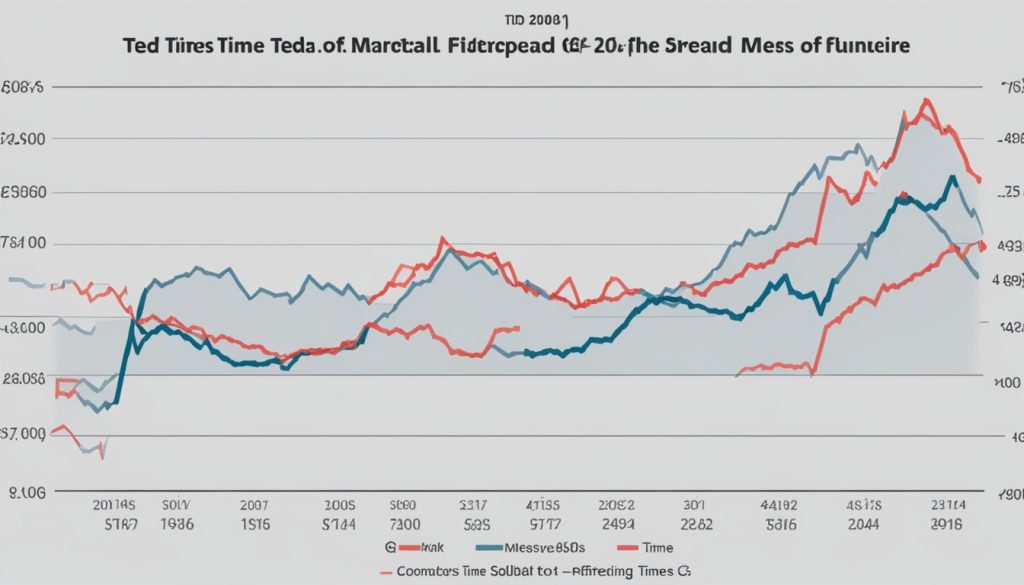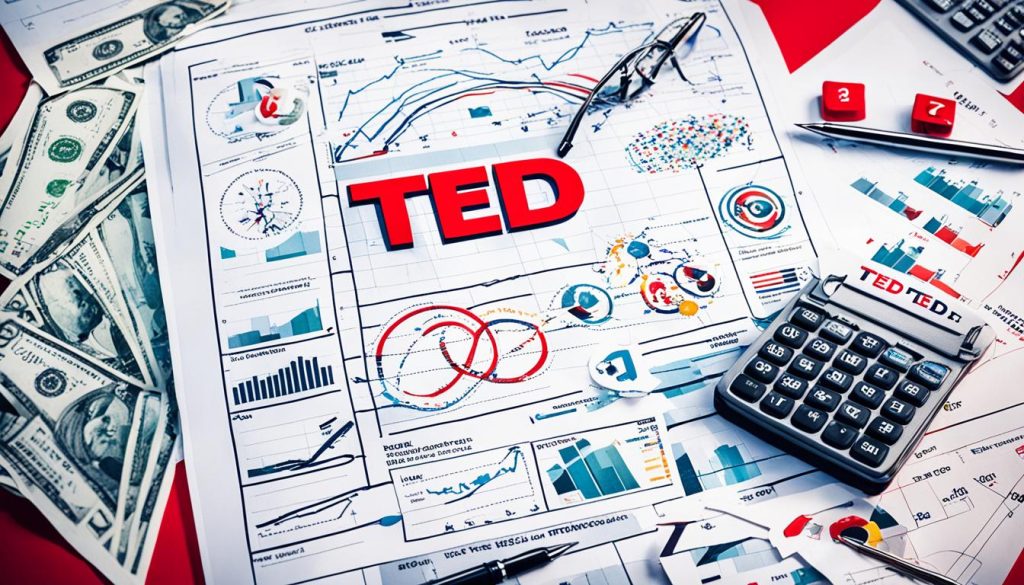The TED Spread is a key economic indicator that shows how the financial markets are doing. It looks at the difference between the interest rates on U.S. Treasury bills and Eurodollar deposits for three months1. This spread tells us about the credit risk and how easy it is to get money in the market1. It’s a vital tool for understanding the market and spotting potential economic problems1.
The TED Spread became more important during big financial crises, like the 2008 global financial crisis1. It helps measure how confident people are in the market and how much risk they’re willing to take1. If the spread gets bigger, it means people think there’s more risk and less money around. But if it gets smaller, it means people are feeling better about the market and taking less risk1.
Key Takeaways
- The TED Spread is a key indicator of credit risk and liquidity in the financial markets.
- A widening TED Spread signals increased perceived risk and market stress, while a narrowing spread suggests improved confidence.
- The TED Spread gained prominence during major financial crises, such as the 2008 global financial crisis.
- Analyzing the TED Spread alongside other indicators can provide a comprehensive view of market conditions and risk.
- Investors can use the TED Spread to inform their risk management, market timing, and portfolio diversification strategies.
- https://tunekong.com/indoor-plants-101-the-best-green-companions-for-a-fresh-vibrant-home-11/
Understanding the TED Spread
Definition and Calculation
The TED spread is a key financial measure. It shows the difference between U.S. Treasury bill rates and the London Interbank Offered Rate (LIBOR)23. This spread tells us how much banks charge each other for loans, showing their trust in each other.
To find the TED spread, subtract the 3-month Treasury bill yield from the 3-month LIBOR3. Normally, this spread is between 10 and 50 basis points (0.1% and 0.5%)23. But if it goes above 48 basis points, it might mean trouble for the economy2.
When financial times get tough, the TED spread can jump a lot. For example, in 2007-2008, it hit 150 to 200 basis points, peaking at over 300 basis points on September 17, 20082. On October 10, 2008, it reached 457 basis points, showing big worries about lending and money flow2.
The TED spread helps us see how financial markets are doing. A bigger spread means banks are worried about lending to each other, showing they don’t trust each other much3. A smaller spread means they’re more confident and stable in lending to each other.
“The TED spread is a key indicator of perceived credit risk in the general economy. A rising TED spread often signals an increased reluctance of banks to lend to one another, which can be a harbinger of broader financial stress.”
The TED spread is still a key metric today, giving us insights into the economy and financial health23.
Significance of the TED Spread
The TED Spread is key for checking the banking system’s health and market feelings4. It shows how banks trust each other, which reflects their trust in the financial world4. A big TED Spread means banks see more risk, which could warn of a financial crisis4. But a small TED Spread means things are looking up and risks are lower.
The TED Spread is the difference between LIBOR and the Treasury Bill rate5. This shows the credit risk in the economy tied to economic ups and downs5. The LIBOR-OIS spread looks at liquidity and risk in the short-term money market5. The Swap Spread checks the risk of not paying back in the corporate world5. The CFAI Curriculum says the TED Spread is better at showing banking risk than the 10-year swap spread, which is more about supply and demand5.
Watching the TED Spread helps investors, policymakers, and analysts understand the financial markets’ mood and stability4. A big TED Spread warns of a possible financial crisis, calling for action to avoid economic trouble4. But a small TED Spread means the market is doing well and risks are down, which could lead to more investment and growth.

“The TED Spread is a widely watched indicator of credit risk in the financial markets, reflecting the willingness of banks to lend to one another.”
| Indicator | Description | Relationship to Credit Risk |
|---|---|---|
| TED Spread | Difference between LIBOR and Treasury Bill rate | Measures overall credit risk in the economy |
| LIBOR-OIS Spread | Difference between LIBOR and Overnight Indexed Swaps rate | Indicator of liquidity and risk perception in the money market |
| Swap Spread | Difference between swap rate and government bond yield | Measures counterparty credit risk in the corporate world |
In summary, the TED Spread is key for understanding the banking system and market feelings4. It helps investors and policymakers see credit risk and potential financial trouble4. This info aids in making decisions and can lessen the effects of financial crises4.
The TED Spread and Credit Risk
The TED spread is a key indicator of credit risk. It shows the financial health of markets3. Looking at its history helps us understand credit risk and its effects on the economy.
When financial stress hits, the TED spread goes up a lot. This shows how risky the market feels. For example, in 2008, it reached a record high of 465 basis points6. This meant a big risk in the banking sector and a lack of trust.
The Eurozone debt crisis in 2011 also made the TED spread jump around a lot7. This showed big worries about European banks and the financial system. These events prove how closely the TED spread and credit risk are linked. Markets worry a lot about defaults and liquidity problems.
| Event | TED Spread Peak | Impact on Credit Risk |
|---|---|---|
| Global Financial Crisis (2008) | 465 basis points6 | Severe credit risk and lack of trust in the banking sector |
| Eurozone Debt Crisis (2011) | Significant volatility7 | Heightened concerns about the stability of European banks and the broader financial system |
The TED spread is very sensitive to credit risk events. It’s a key tool for watching market conditions and predicting financial trouble. By knowing its history and how it relates to credit risk, investors and financial experts can make better decisions.
The TED spread is still very important for checking the health of credit markets and the global financial stability763.
Factors Influencing the TED Spread
The TED Spread is a key economic indicator. It’s affected by central bank policies, economic indicators, and market sentiment8. These elements greatly shape the TED Spread and its effects on financial health.
Central bank policies, like changing interest rates, directly affect the TED Spread9. Lowering interest rates to boost growth can make the TED Spread smaller as borrowing costs drop9. But raising rates to fight inflation can make the TED Spread bigger as banks lend less.
Economic indicators like GDP growth, job numbers, and inflation rates also impact the TED Spread8. If the economy looks weak, the TED Spread might grow as banks see more credit risk and want higher lending premiums8. Good economic news can make the TED Spread smaller.
Market sentiment is key to the TED Spread too9. When investors feel more credit risk or financial instability, the TED Spread goes up as banks charge more for loans9. But, when markets are optimistic, the TED Spread can get smaller.
Knowing what affects the TED Spread helps investors, policymakers, and financial experts make better choices8. Watching the TED Spread gives insights into market conditions and credit risk. This helps them move through the financial world better8.

“The TED Spread is a crucial barometer of financial health, reflecting the interplay between central bank policies, economic indicators, and market sentiment.” – Financial Analyst, XYZ Research
Interpreting the TED Spread
The TED Spread is key for understanding credit risk and investment choices in finance. Interpreting the TED Spread means knowing how it links with other important signs and market factors6.
Normally, the TED Spread moves between 10 and 50 basis points6. But in tough economic times, like the 2008 crisis, it can jump to 465 basis points6. This big jump shows big worries about default risk and credit risk in banks.
Many things affect the TED Spread, like economic news, world events, changes in money policies, how investors feel, and how safe government securities seem6. Investors see the TED Spread as a way to predict economic downturns. A rising spread means more concerns about default risk6.
The TED Spread helps investors, companies, banks, and central banks. Investors use it to see market risk. Companies plan their financing based on it6. Banks use it for managing risk, and central banks check how well their money policies work6.
When looking at the TED Spread, think about it with other signs like the LIBOR-OIS Spread and the yield curve6. The LIBOR-OIS Spread shows credit risk in banks too10. The yield curve helps understand economic conditions and the TED Spread better6.
In short, the TED Spread is important for managing risk, making investment plans, and making financial decisions across the economy6. Knowing how it works and its place in the market helps investors and experts make better choices10.
| Metric | Definition | Implications |
|---|---|---|
| TED Spread | The difference between the 3-month US Treasury Bill rate and the 3-month LIBOR10. | A TED Spread of less than 0.50 is low and means little financial risk. A spread over 1.0 shows uncertainty and risk in the global financial system10. |
| LIBOR-OIS Spread | The difference between the 3-month LIBOR and the 3-month Overnight Index Swap (OIS) rate. | This spread gives more info on credit risk in banks. |
| Yield Curve | The relationship between the yields of fixed-income securities and their time to maturity. | This curve gives context on economic conditions and their effect on the TED Spread. |
“The TED Spread is a key indicator of risk in the global financial system. Watching its changes and understanding its market context is key for smart investment choices.”
Conclusion
The TED spread is key for checking credit risk in financial markets11. It usually was under 50 basis points but has been over 100 since August 2007. It hit 300 basis points a few times in the last two weeks11. Knowing about the TED spread and its history helps investors and analysts understand today’s economy better.
Looking at what affects the TED spread, like low interest rates and possible rising corporate rates12, helps investors make smarter choices12. With interest rates going up, the TED spread will be even more important for checking the global economy’s health12.
So, keeping an eye on the TED spread and other financial signs is key for credit risk evaluation, seeing the financial market monitoring health, and making smart investment choices. By watching the TED spread closely, you can move through the financial world with more confidence and aim for long-term success.
FAQ
What is the TED Spread?
The TED Spread is a key economic indicator. It shows the difference between U.S. Treasury bill rates and Eurodollar deposit rates. It tells us about the financial markets and what investors think about credit risk and market liquidity.
How is the TED Spread calculated?
To find the TED Spread, you subtract the U.S. Treasury bill yield from the LIBOR. This shows the extra cost banks pay for loans in the interbank market.
Why is the TED Spread important?
The TED Spread helps us understand the banking system and market feelings. It shows how willing banks are to lend to each other. A big TED Spread means banks are worried about lending, which could mean trouble for the economy.
How has the TED Spread behaved during financial crises?
During big financial troubles, like the 2008 global crisis and the 2011 Eurozone crisis, the TED Spread went up a lot. This shows banks were really worried about lending to each other.
What factors can influence the TED Spread?
Many things can change the TED Spread. This includes what central banks do, economic news, and how people feel about the market. For example, when the Federal Reserve changes interest rates, it can affect the TED Spread.
How can investors use the TED Spread?
Investors can use the TED Spread to make better investment choices. A big TED Spread might mean good times for investments that are more risky. A small spread could mean it’s a good time for riskier investments.
Source Links
- Understanding The Ted Spread – FasterCapital
- TED spread
- What Is the TED Spread? Definition, How It’s Used and Calculation
- What Is The TED Spread Telling Investors About The Credit Market?
- Ted Spread, LIBOR OIS, Swap what exactly it represents?
- TED Spread | Definition, Calculation, Interpretation, Applications
- Seeking causality between liquidity risk and credit risk: TED-OIS spreads and CDS indexes
- Federal Reserve: Analyzing the Ted Spread and the Federal Reserve’s Role – FasterCapital
- Interest rates: Uncovering the Impact of Interest Rates on the Ted Spread – FasterCapital
- TED Spread & LIBOR: What Every Investor Should Know – Arbor Asset Allocation Model Portfolio (AAAMP) Value Blog
- Understanding the TED spread | Econbrowser
- The TED Spread: What It Is & Why It Matters

